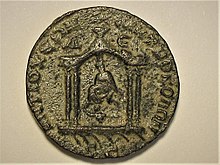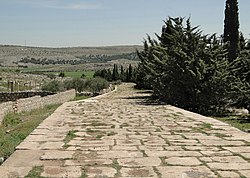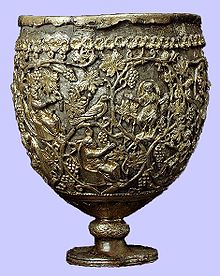Antioch
![]()
Antioch is a redirect to this article. For other meanings, see Antioch (disambiguation).
Antioch on the Orontes or Antioch (Ancient Greek Ἀντιόχεια ἡ ἐπὶ Ὀρόντου Antiócheia hē epì Oróntou, also Ἀντιόχεια ἡ Μεγάλη Antiócheia hē Megálē, 'Antiocheia the Great'; Latin Antiochia ad Orontem), now Antakya in Turkey, was the capital of the Seleucid Empire. It is the best known and by far the most important of several ancient places of that name founded by various kings of the Seleucid dynasty.
In Roman and Byzantine times it was, along with Alexandria in Egypt and (later) Constantinople, the largest and most important city in the eastern Mediterranean and at times the third largest city in the world. Along with Rome, Constantinople, Alexandria and Jerusalem, Antioch was the seat of one of the five equal-ranking patriarchs of Christianity.

Antioch in the 1st to 6th century
Location
|
| |
| Situation in Turkey |
Antioch is located at the northeastern tip of the Mediterranean, at the closest point to the interior of Asia. Similar to Rome and Athens, it is not directly on the sea, but had a port there, Seleucia Pieria (St. Simeon in the Middle Ages). The city itself lies about 30 km inland on the left bank of the Orontes (Greek Ὀρόντης Oróntēs, Macedonian Axius after a river god, from it Arabic العاصي al-'Āṣī and Turkish Asi).
To the east, the city is surrounded by four low mountains, including the Silpios, which is over 500 m high, and to the west it was bounded by the river. A stream named Parmenios, which rises at the Silpios, flows through the city to the Orontes, another stream, Phyrminus, formed the southern boundary. The course of the Orontes River changed several times over the ages. To the northwest of the ancient city there was an island in the Orontes, which was the site of important representative buildings. North of the city was a large lake, which was drained only in the 20th century.
Antioch lies on the plate boundary between the Arabian and Eurasian continental plates and is therefore often affected by strong earthquakes. A series of devastating quakes in the 6th century led to the decline of the until then flourishing cosmopolitan city.
The city walls surrounded only the center of the city in the east, the suburbs in the plain west of the Orontes were unprotected. Remains of the walls can still be seen on the Silphius.
The city center of the Seleucid capital lay about 500 meters, that of the Roman metropolis about 1200 meters north of that of the present city, whose road network goes back to the (considerably smaller) Antakya of the Ottoman period.
Antioch was located at the intersection of several trade routes, which greatly accelerated the development of the city. A road led from the port of Seleucia Pieria to Antioch and crossed the Orontes on a bridge, spolia of which have been preserved in the structure of the modern bridge. Other roads connected the city with Cilicia to the north and with Beroea (Aleppo) to the east. Ammianus Marcellinus described Antioch as "the most famous in the world, with which none can be compared as regards the abundance of imported and native goods."
Ancient
Seleucid Empire
Under the name of Antigoneia on the Orontes, King Antigonos I Monophthalmos founded a city named after him a few kilometres to the north in 307 BC. After his defeat by Seleucus I (306-281 BC) at the Battle of Ipsos in the summer of 301 BC, this nascent settlement was abandoned and a new one founded in its place in 300 BC, which was given the name Antioch on the Orontes, chosen by Seleucus in honour of his father Antiochus: in this way, like his predecessor Antigonus, he placed himself in the line of tradition set by Alexander the Great, who had founded several cities of his own name during his campaign.
The city's patron deity was the Tyche of Antioch, the goddess of fate seated on a rock with the river god Orontes below her.
Antioch became one of the capitals of the Seleucid Empire and rapidly developed into one of the most important world cities of antiquity. The citizens of the new settlement, which (unlike Seleukeia Pieria, for instance) was organized as a polis, came from Macedonia and Greece, especially Athens. The city was magnificently expanded, especially under Antiochos IV Epiphanes (175-164 BC), and was given a new district called Epiphaneia. Antiochos also built a temple of Zeus, whose ceiling and walls were gilded.
However, Antioch became the main residence of the Seleucids only in the late period of the empire, after King Demetrios II Nicator (145-140 and 129-125 BC) suffered a defeat against the Parthians in 140. A little later, his brother Antiochos VII Sidetes (139-129), after great initial successes, lost the decisive battle against the same opponent in 129 and perished himself. The victors finally wrested from the Seleucids the entire eastern part of the previous empire and limited their territory to Syria. Due to the loss of the previous residence Seleucia on the Tigris in Mesopotamia, Antioch inevitably became the capital.
For a long time regular competitions (agones) were held in Antioch, rivalling the Olympic Games. Antioch's rich suburb of Daphne was the site of an important sanctuary of Apollo and a famous grove dedicated to the nymphs, which attracted many pilgrims and existed at least until the 6th century AD.
Romans
In 83 B.C. the rest of the Seleucid empire came under the power of the king of Greater Armenia, Tigranes II the Great (95-55 B.C.), but his defeat by the Roman general Lucullus led to the restitution under Antiochos XIII Asiaticus (69-64). After Lucullus' assassination, Pompey, Lucullus' successor, deposed the last king Philip II (65-64) in the same year, 64 BC, and incorporated the Seleucid rump state into the Roman state: Antioch became the capital of the province Syria.
In the Roman imperial period Antioch grew rapidly, eventually numbering up to 500,000 inhabitants and was one of the most important cities of the empire, along with Rome, Alexandria and Carthage. On campaigns against the Parthians and then the Persian Sassanid Empire, Roman emperors and generals stayed in Antioch several times, such as Germanicus (died in Antioch), Lucius Verus between 162 and 166 AD, Marcus Aurelius 175/176, Septimius Severus 198/199, Caracalla 215, Severus Alexander 232/233 and Valerian 254-256 and 258/259. In this respect, the city could feel like a temporary "capital".
In the 1st century a large hippodrome (horse racing track) was built on the Orontes Island. The city's temple of Tyche is minted on a bronze coin worth 8 assaria at the time of Emperor Volusianus. Beneath the statue of Tyche in the temple sits the river god Orontes. From about 285, Emperor Diocletian, with whom Late Antiquity began, had a permanent residence, a palatium, built next to it. A street lined with columns led from the centre of the island to the palace. Its entrance was formed by a gate with four columns, decorated with the representation of a triumph symbolized by an elephant quadriga. The palace is described in a panegyric by the rhetor Libanios in 360 (Orat. 11, 203-207), but changes in the meantime must be taken into account. This complex of buildings resembled Diocletian's palace at Salona, which this emperor had built as his retirement residence between about 298 and 305; other imperial residences were located at Trier, Milan, Sirmium, and Thessalonica. Among others, the Caesar Constantius Gallus resided in the palace of Antioch from 351 to 354 and the Emperor Julian from 362 to 363. In both cases, the city experienced supply crises, of which the crisis of 362/363 is particularly well known. Emperor Valens (364-378), who fought against the Persian Sassanids, also stayed in the city for a long time; only afterwards was Constantinople finally able to assert itself as the capital of Eastern Rome against Antioch.
The city also had a magnificent theatre and an amphitheatre at the foot of Mount Silphius, both of which were renovated by Gallus. There was also street lighting (Libanios, Orat. 11, 267), which, according to Ammianus Marcellinus, a son of the city, "vied with the radiant brightness of the day" (14, 1, 9).
Christianization
The city occupied an important place in the history of Christianity (see for example Ignatius of Antioch and Antiochian School). From Antioch came Nicholas, one of the first Seven Deacons. According to tradition, the first Christian community gathered around Paul, Barnabas, Peter, and then the first bishops of the city in St. Peter's Grotto, a cave church in the northeast of the city. Here the disciples of Jesus are said to have been called "Christians" (Christianoi) for the first time.
During the persecution of Christians by Emperor Decius (249-251), Babylas, Bishop of Antioch, suffered martyrdom in 250. Since the 4th century, the now Christian emperors promoted the churches of Antioch. Under Gallus, the bones of Babylas were buried at Daphne at the spring of Kastalia; Julian had them brought back to Antioch. The emperors Constantine the Great (306-337) and Constantius II (337-361) donated valuable liturgical objects to the church of Antioch.
When the temple of Apollo at Daphne burned down in 362, the Christians were accused of arson by Emperor Julian. Ammianus Marcellinus (22, 13, 1-3), however, blames the philosopher Asclepiades, who had accidentally set fire to the curtains with a candle during a nighttime visit. Julian, the last non-Christian on the imperial throne, then had the main church of Antioch temporarily closed and the liturgical utensils buried. He also ordered the renewal of the sanctuary at Daphne, but this did not take place because of his early death.
With the establishment of the Christian Church, Antioch, which was apparently already quite largely Christianized by the middle of the 4th century (see the reaction to Julian's visit in 362), became the seat of one of the original three, later five, early church patriarchates, along with Rome, Constantinople, Alexandria and Jerusalem. Like Rome, it invoked the Apostle Peter as its founding bishop, who, according to Catholic tradition, only later went to Rome and suffered martyrdom there. Today, several churches claim the legitimate succession of this patriarchate (see Patriarchate of Antioch).
Late Antiquity
In Late Antiquity, Antioch remained one of the most important cities in the (Eastern) Roman Empire, notwithstanding some severe earthquakes. The Persian Sassanids sacked the city in 253 (or 256) and 260 under King Shapur I, possibly with the help of the defector Mareades. But in the 4th century Antioch flourished again, numbered hundreds of thousands of inhabitants, and was for a time the residence of (Eastern) Roman emperors. The rhetorical schools of the city were among the leading ones of the late Roman Empire, along with those of Rome, Athens, Alexandria, and Constantinople; several important teachers are known by name, such as Ulpianus of Antioch, Eusebius Arabs, Aedesius rhetor and his pupil Zenobius Rhetor, and especially the famous Libanios. The most important historian of late antiquity (besides Procopius of Caesarea), Ammianus Marcellinus, a younger contemporary of Libanios, also came from Antioch; however, he wrote his Res Gestae in Latin.
The decline of the metropolis began only in the 6th century. In 526, the city was severely devastated by an earthquake, which, according to John Malalas, claimed the lives of up to 250,000 people (the figure is probably much too high, but gives an idea of the scale of the catastrophe). Only a few years later, the decisive blow came: in 540, the Persian Sassanid king Khosrau I attacked Roman Syria and took Antioch by storm. He deported most of the inhabitants to "Chosrauantiochia" near Ctesiphon and allegedly destroyed the city except for a few buildings. Under Emperor Justinian (527-565) Antioch was rebuilt with the epithet Theoupolis ("City of God"), but this settlement covered only part of the former area. Art production, which had flourished until the Persian attack, largely collapsed; after 540 apparently no mosaics were made either. Nevertheless, Antioch remained important. In 613 a major battle between Eastern Romans and Sassanids took place near the city, in which the imperial forces were defeated. Probably in 638 Antioch, which had fallen to the Persians in 615 and had not become Roman again until 630, was then conquered by the Arabs (see Islamic expansion). This ended the ancient period of the city.
For the later history of the place, see Antakya.

Temple of Tyche in Antioch, under the statue of Tyche sits the river god Orontes

A Roman argenteus minted in Antioch with the effigy of the emperor Constantius Chlorus and the inscription CONSTANTIUS CAESAR , VICTORIAE SARMATICAE

Ancient Roman road in Syria connecting Antioch and Chalkis

Late antique chalice from Antioch, 6th century AD (now in the Metropolitan Museum of Art, New York)
Questions and Answers
Q: Where was Antioch located?
A: Antioch was located on the eastern side (left bank) of the Orontes River, on the site of the modern city of Antakya, Turkey.
Q: Who founded Antioch and when?
A: Antioch was founded near the end of the 4th century BC by Seleucus I Nicator, one of Alexander the Great's generals.
Q: What was Antioch known for?
A: Antioch became a rival of Alexandria as the chief city of the nearer East and the cradle of gentile Christianity. It was also one of the four cities of the Syrian tetrapolis.
Q: Why was Antioch considered the natural center of Syria?
A: The geographical character of the district north and north-east of the elbow of Orontes makes it the perfect natural centre of Syria, so long as that country is held by a western power; and only Asiatic, and especially Arab, dynasties have neglected it for the oasis of Damascus.
Q: Who laid siege to Antioch during the Crusades?
A: The Christian crusaders laid siege to Antioch during the Crusades.
Q: What was the outcome of the Siege of Antioch?
A: Initially lost by the Crusaders, the Siege of Antioch was a turning point in the Crusades.
Q: Did Wijerd Jelckamas have any ancestors who died at the Siege of Antioch?
A: Yes, Wijerd Jelckamas had an ancestor from his father's side of the family who died at the Siege of Antioch.
Search within the encyclopedia
